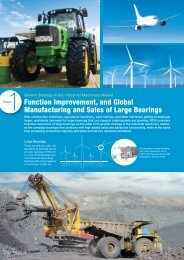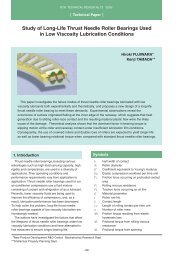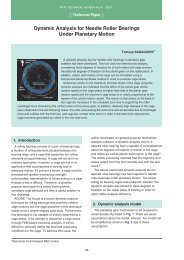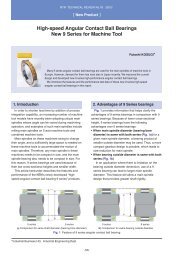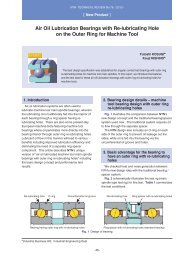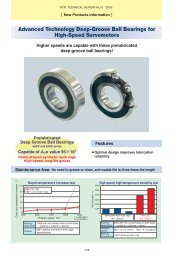Special Issue; Products for Industrial Machinery - NTN
Special Issue; Products for Industrial Machinery - NTN
Special Issue; Products for Industrial Machinery - NTN
You also want an ePaper? Increase the reach of your titles
YUMPU automatically turns print PDFs into web optimized ePapers that Google loves.
The Rust Guard Bearings of Highly Corrosion-resistant Bearings<br />
The initial ef<strong>for</strong>ts to realize longer life <strong>for</strong> roll neck<br />
bearings have included an attempt to achieve a higher<br />
bearing capacity by increasing the number of rollers<br />
through adoption of a pin-type cage and ef<strong>for</strong>ts to<br />
prevent failure that starts internally by adopting<br />
cleaner bearing materials. However, despite these<br />
ef<strong>for</strong>ts, premature failures still occur frequently<br />
because flaking that starts on the surface is<br />
unavoidable. A starting point <strong>for</strong> flaking could be a<br />
rusty spot or dent resulting from the ingress of water<br />
or <strong>for</strong>eign matter into the bearings, and the production<br />
sites in steel mills are usually contaminated with much<br />
water (rolling water and cooling water) and <strong>for</strong>eign<br />
matter (scale and the like). To address this problem,<br />
the lubricant and chock seal were improved, and<br />
sealed bearings have also been incorporated into<br />
components such as the work rolls in cold rolling<br />
machines. Despite these attempts, ingress of water<br />
and <strong>for</strong>eign matter has been unavoidable.<br />
<strong>NTN</strong> has already marketed the EA Bearings, which<br />
are specially heat-treated products boasting limited<br />
loss in life even in contaminated conditions. This<br />
product line has attained a good reputation, and, when<br />
installed on a hot rolling machine, this bearing type<br />
has achieved L10 life three times as long compared<br />
with conventional bearings.<br />
Incidentally, the problem known as “downtimeinduced<br />
rust” (Photo 2) should be noted. This results<br />
from the ingress of water into the bearing and occurs<br />
when the bearing is at a standstill while the rolls are<br />
being polished or inspected. To address this type of<br />
rusting, <strong>NTN</strong> developed a special phosphating<br />
process (hereafter referred to as the “previous<br />
specification”) and has adopted this technique in<br />
conjunction with EA Bearings on actual steel mill<br />
machinery, verifying its effectiveness.<br />
However, despite our ef<strong>for</strong>ts, the need to further<br />
improve the corrosion resistance of bearings has been<br />
mounting because much longer maintenance intervals<br />
are needed at the workplaces of steel manufacturers.<br />
3. Features of RustGuard<br />
The author’s newly developed RustGuard coating is<br />
a unique type of coating with improved corrosion<br />
resistance that was developed through further<br />
improvement of the previous special phosphate<br />
bearing coating (previous specification).<br />
A phosphate coating is a type of a chemical<br />
conversion coating, in which chemical reactions with<br />
the compositions of the steel base material <strong>for</strong>m<br />
crystals and an accumulation of these crystals creates<br />
the phosphate coating. Generally, phosphate coating<br />
is used to provide the initial sliding fit <strong>for</strong> sliding<br />
sections or to prepare a base <strong>for</strong> the application of<br />
paint. The purpose of phosphating on the bore surface<br />
of the inner ring of ordinary roll neck bearings is to<br />
provide initial sliding fit <strong>for</strong> sliding sections.<br />
Capable of retaining lubricating oil between its<br />
crystals due to the capillary effect, the phosphate<br />
coating also provides corrosion resistance. However,<br />
because the base material is somewhat attacked<br />
during the initial coating <strong>for</strong>mation process, the<br />
roughness of the base material surface (boundary with<br />
the coating) will deteriorate and can lead to loss in<br />
rolling life even though the oil retention capability of<br />
the base material will be improved. There<strong>for</strong>e, the<br />
ordinary phosphate coating cannot be applied to the<br />
raceway surface of a bearing.<br />
To address this problem, <strong>NTN</strong> has long been<br />
applying a special phosphate coating that does not<br />
lead to loss in rolling life by employing a special<br />
miniaturization technology. Photo 3 shows rollers of<br />
the previous specification that underwent operation <strong>for</strong><br />
a duration equivalent to five times as long as the<br />
calculated life L10 and new non-treated rollers. Both<br />
samples were partially submerged <strong>for</strong> 24 hours in tap<br />
water. From the state of rusting at the water surface of<br />
each sample, it can be seen that the rollers of the<br />
previous specification maintained corrosion resistance<br />
after use.<br />
-97-<br />
Downtimeinduced<br />
rust<br />
Flaking resulting from<br />
downtime-induced rust<br />
Photo 2 Examples of Downtime-Induced Rust



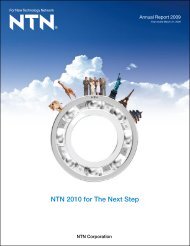
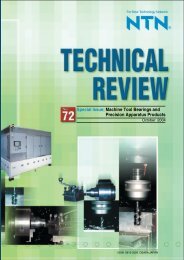
![[New Product] Unit Products for Office Equipment - NTN](https://img.yumpu.com/27154451/1/184x260/new-product-unit-products-for-office-equipment-ntn.jpg?quality=85)
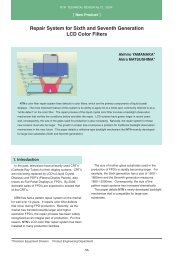
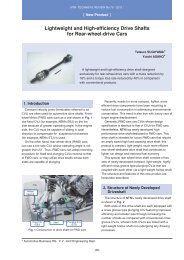
![[New Product] Development of Oil-impregnated Sintered ... - NTN](https://img.yumpu.com/27154427/1/184x260/new-product-development-of-oil-impregnated-sintered-ntn.jpg?quality=85)

